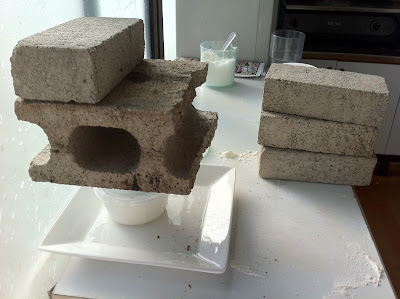I discovered ricotta salata through desperation. I don't have access to cultures needed to make cheese. I did some research, and found that I could simply press ricotta into a cheese mold to produce a semi-hard cheese.
What is Ricotta Salata?
Ricotta salata is an Italian cheese made from sheep's milk. In its beginning stages, it's just ricotta. The difference is that it's then pressed, salted, dried, and aged. It's hard enough so that you can slice, grate, or shave it. It tastes salty and milky, and like Parmigiano Reggiano, it's a punchy little cheese that can go on top/into an endless number of dishes.
What Do I Need to Make Ricotta Salata?
The list is quite simple. You're just making ricotta, and then from there you'll need a cheese mold, something heavy, and time. I outline how to make ricotta in a separate blog post.
Though traditionally, ricotta salata is made from sheep's milk; traditions, for the most part, suck (i.e. female castration and baseball). So, I'm going with what I can get. Goat's milk.
 |
| 840 mL for 5,400 won at E-Mart |
How to Make a Cheese Mold
Find a container that has the following:
- sides perpendicular to the bottom like a tube or box, not too much slanting
- shape that you want for your cheese
- easy to puncture skin (i.e. semi-disposable containers like the ones made by Ziploc)
In addition to the containers, you'll need something to puncture it. I found that these wine openers worked perfectly. I also tried using a screwdriver, nails, blackhead remover (ew, I know), earrings...
 |
| Don't they look like they're dancing? |
 |
| Noel is not a hand model. |
Next, I lined the cheese mold with cheese cloth. You can use any fine-weave material. I've used a scarf before. Fill it up with your ricotta. Before pressing the cheese, give the ricotta a good squeeze to try and get out as much as whey as possible before resorting to the press.
Neatly fold the cheesecloth over the ricotta. This affects how the cheese will be molded so try to fold evenly so that the cloth won't imprint too many strange dents into the cheese.
If you don't have an identical container, you'll just need something that will fit right into the inside of the container so that it can press the cheese. I've seen people use plastic or metal sink drainers, which would save you the trouble of poking a million little holes into a plastic container with a rusty screwdriver. *Updated: I wrote a post about using these, here.
When you weight the cheese press, use 25+ pounds (11+ kg) of weight. Put a plate under the cheese for the excess whey to drip off into. Do this for one hour on one side then flip, and weight it for 12 hours to overnight on the other side.
This is what your cheese will look like the next day. From now on, the cheese needs to be stored in the refrigerator to age with the lid on.
Over the next week, you'll need to take it out of the refrigerator daily, and salt it by gently rubbing the outside with coarse salt. Each time you take the cheese out, flip it. Wipe off any moisture, and if any mold grows on it, just scrape it off.
After of week of lovingly salting and flipping your cheese baby, let it age for at least one more week up to 3 weeks. I took mine out occasionally to flip it so it wouldn't dry out. I let mine age for the minimum of one week because I couldn't wait.
To commemorate my first pressed cheese, I made pasta from scratch and cooked up some linguine primavera topped with ricotta salata.
Next, I'm trying ricotta salata with cow's milk and fresh herbs.
















Good stuff and well explained.
ReplyDeleteLove the post and the blog and the pics...but BASEBALL DOESN'T SUCK!!! I dare you to watch a duel between a premier pitcher and a premiere hitter, pitch-by-pitch, and repeat that nonsense.
ReplyDeleteYou're better than that. It's akin to me saying cheese is horrible because of Velveeta.
CSB
A debt of gratitude is in order for sharing this extraordinary article! That is extremely intriguing I love perusing and I am continually scanning for useful data like this.
ReplyDeleteHouse Mold Testing Cooper City